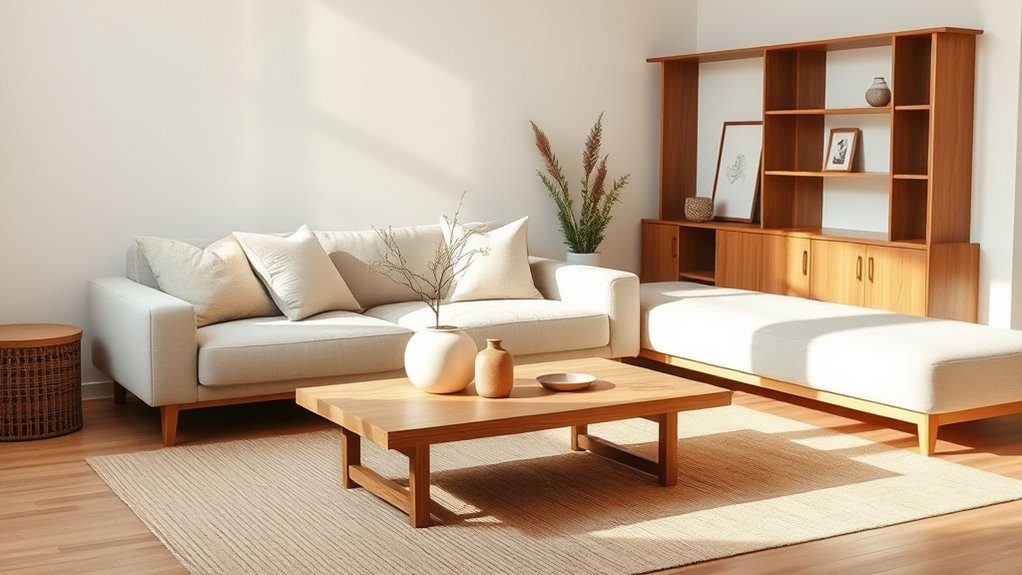To embrace Japandi style at home, focus on simplicity and natural materials. Use neutral tones like beige and soft gray, and incorporate clean-lined furniture for a minimalist look. Bring in indoor plants, such as bonsai or bamboo, to enhance tranquility. Opt for multi-purpose designs and built-in storage to keep spaces uncluttered. Layer soft textiles and use warm lighting to create a cozy atmosphere. Want to explore more ways to enhance your Japandi-inspired sanctuary?
Key Takeaways
- Choose a neutral color palette with earthy tones like beige, taupe, and soft grays to create a calming environment.
- Incorporate natural materials such as wood, stone, and bamboo in furniture and decor for a sustainable touch.
- Embrace functional minimalism by selecting high-quality, multi-purpose furniture that maintains clean lines and reduces clutter.
- Add indoor plants like bonsai or bamboo to enhance tranquility and connect with nature.
- Use soft lighting and layered textiles to create a cozy atmosphere while maintaining open, uncluttered spaces.
Understanding Japandi Style
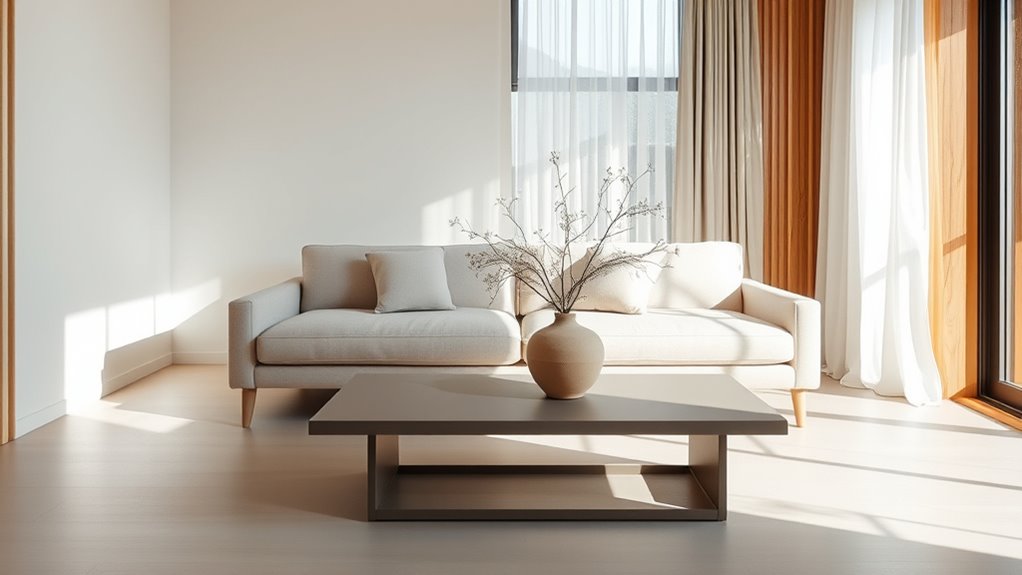
When you explore Japandi style, you’ll discover a harmonious blend of Japanese and Scandinavian design principles that prioritize simplicity and natural materials.
This unique interior design style emphasizes an uncluttered space, allowing you to create a serene environment. The neutral color palette, featuring earthy tones, sets a calming backdrop for clean lines and functional furniture.
Japandi embraces the wabi-sabi philosophy, celebrating the beauty in imperfection and promoting a cozy atmosphere reminiscent of hygge.
Embracing wabi-sabi, Japandi finds beauty in imperfection, creating a warm and inviting space that evokes a sense of hygge.
Large windows invite natural light, enhancing your connection with nature and fostering tranquility.
Key Characteristics of Japandi Design
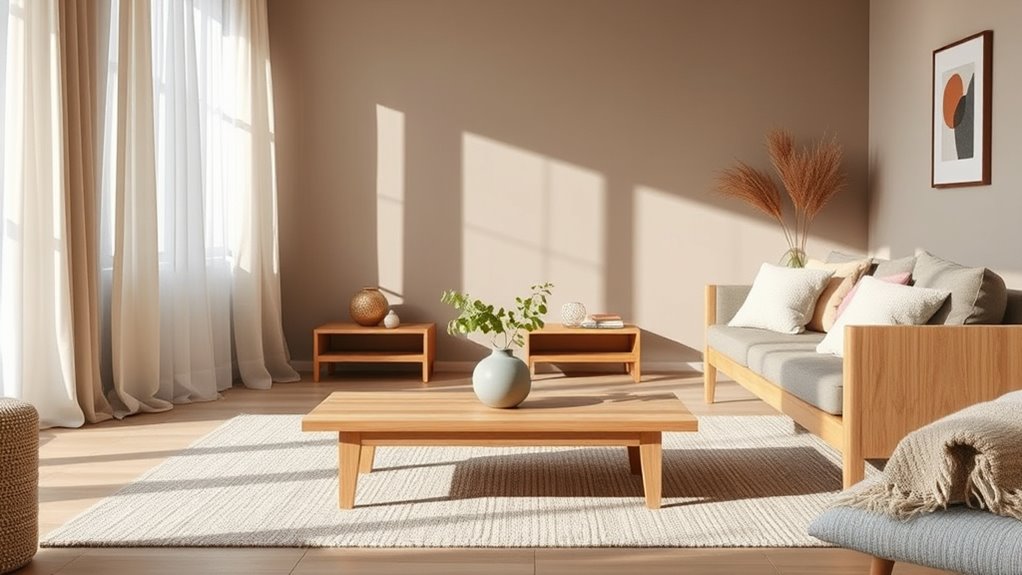
Japandi design showcases a unique fusion of Japanese and Scandinavian aesthetics that prioritizes simplicity and natural beauty. This style emphasizes functional pieces crafted from natural materials like wood and stone, creating serene living environments that feel both cozy and sophisticated.
| Key Characteristics | Description |
|---|---|
| Neutral Tones | Earthy colors like beige, taupe, and soft grays |
| Clean Lines | Minimalistic furniture with a focus on form |
| Wabi-Sabi Philosophy | Embraces imperfection in handcrafted items |
| Natural Materials | Promotes sustainability and a connection to nature |
| Functional Pieces | Multi-purpose designs that enhance simplicity |
Incorporating these elements into your home can transform it into a tranquil retreat, reflecting the beauty of both Japanese design and Scandinavian aesthetics.
Incorporating Natural Elements Into Your Space
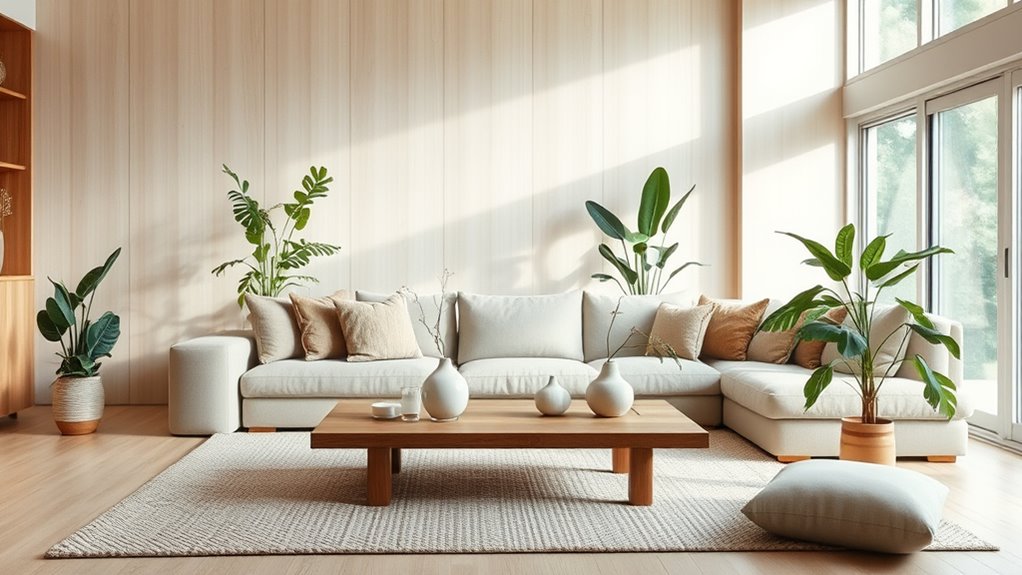
There’s something incredibly soothing about incorporating natural elements into your space, and it’s a key aspect of achieving that Japandi aesthetic.
To enhance comfort and foster a connection with nature, add a variety of indoor plants like bonsai or bamboo. Choose natural materials such as wood, stone, and bamboo for your furniture and decor, reinforcing the organic feel of Japanese and Scandinavian design.
Enhance comfort and nature’s connection by incorporating indoor plants and natural materials in your decor.
Maximize natural light by utilizing large windows or sheer curtains that create a tranquil atmosphere, seamlessly blending your indoor spaces with the outdoors.
Also, consider creating areas that encourage outdoor living, like sunrooms or patios adorned with greenery.
Embracing handcrafted items and artisanal textiles will add personal touches while celebrating the beauty of nature in your space.
Emphasizing Functional Minimalism

To create a truly serene home, emphasizing functional minimalism is essential in achieving the Japandi aesthetic. Focus on purposeful design, ensuring each piece of high-quality furniture serves a distinct function while enhancing the overall look.
Clean lines and subtle details contribute to open spaces and clutter-free surfaces, fostering a calming environment. Incorporate built-in storage solutions to minimize mess and promote mindfulness in your daily life.
By choosing neutral colors and natural materials, you can maintain a cohesive style that supports the intentional atmosphere characteristic of Japandi style.
Creating a Cozy Atmosphere
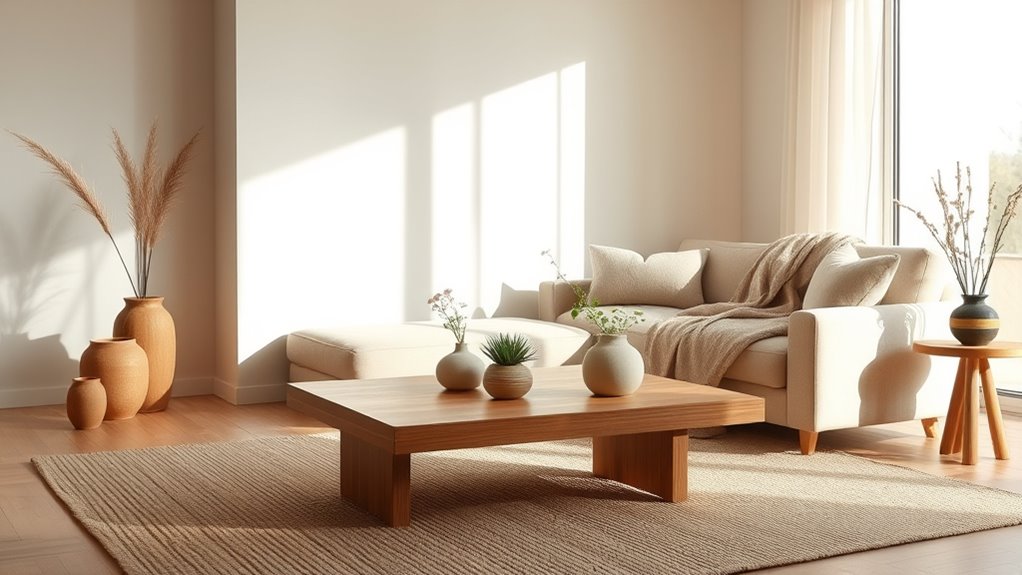
Creating a cozy atmosphere in your home can be effortlessly achieved by embracing the Japandi style.
Start by incorporating soft lighting, using warm lamps and candles to enhance the inviting feel of your space.
Layer textiles like wool throws and linen drapes for added warmth and comfort, vital for a snug environment.
Utilize natural materials, such as wood and stone, in your furniture and decor to create an organic, welcoming ambiance that connects you to nature.
Don’t forget to add plants like bonsai or bamboo, which bring life indoors and enhance the tranquil feel.
Finally, maintain open spaces and uncluttered surfaces to promote calmness and mindfulness, essential elements of a cozy Japandi-inspired home. Additionally, consider incorporating natural elements into your decor, as they promote tranquility and enhance visual appeal.
Frequently Asked Questions
How to Achieve Japandi Style?
To achieve Japandi style, start by decluttering your space to foster tranquility.
Opt for a neutral color palette with earthy tones that promote calmness.
Incorporate natural materials like wood and stone in your furniture for warmth.
Choose multi-functional pieces that blend beauty with practicality.
Finally, bring nature indoors by adding plants and maximizing natural light, creating a harmonious connection between your interior and the outdoors.
This approach will elevate your space’s aesthetic beautifully.
What Are the Best Colors for Japandi?
When you’re choosing colors for Japandi style, focus on muted, earthy tones like beige, soft grays, and buff browns.
These shades create a serene atmosphere that reflects nature. You can enhance the restful quality with off-whites for a neutral base.
Consider adding deep blues or forest greens as accents to bring depth without overwhelming the palette. Mid-tone, green-based grays also fit well, ensuring a calming and cohesive ambiance throughout your space.
Why Is Japandi so Expensive?
Did you know that handmade furniture can cost up to 50% more than mass-produced pieces?
Japandi style’s higher price tag comes from its focus on quality materials, like sustainable woods and artisanal craftsmanship.
You’re not just buying furniture; you’re investing in unique, durable items that reflect conscious consumerism.
The minimalistic approach emphasizes fewer, well-crafted pieces, which can increase your overall costs, especially with custom designs and eco-friendly elements.
What Is the Difference Between Japandi Style and Wabi-Sabi?
Japandi style and Wabi-Sabi both appreciate nature and craftsmanship, but they differ in focus.
When you look at Japandi, you’ll see a blend of Japanese minimalism and Scandinavian functionality, creating clean lines and a balanced color palette.
In contrast, Wabi-Sabi celebrates imperfection and the beauty of aged materials, often embracing asymmetry and earthy tones.
While Japandi aims for a serene space, Wabi-Sabi invites a deeper emotional connection to the imperfect objects around you.
Conclusion
Embracing Japandi style at home can transform your space into a serene retreat. Did you know that homes designed with minimalism can reduce stress levels by up to 50%? By blending the warmth of Japanese aesthetics with Scandinavian functionality, you’ll not only create a cozy atmosphere but also cultivate mindfulness in your daily life. So go ahead, incorporate natural elements, focus on functional designs, and watch your home become a harmonious haven.
